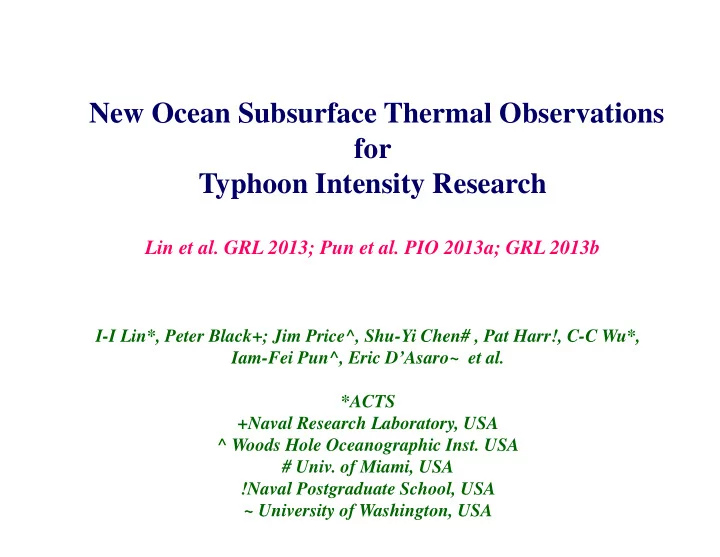

New Ocean Subsurface Thermal Observations for Typhoon Intensity Research Lin et al. GRL 2013; Pun et al. PIO 2013a; GRL 2013b I-I Lin*, Peter Black+; Jim Price^, Shu-Yi Chen# , Pat Harr!, C-C Wu*, Iam-Fei Pun^, Eric D’Asaro~ et al. *ACTS +Naval Research Laboratory, USA ^ Woods Hole Oceanographic Inst. USA # Univ. of Miami, USA !Naval Postgraduate School, USA ~ University of Washington, USA
Little Improvement in TC intensity forecast in the past 20 years Rappaport et al. BAMS 2012 (AMS)
Intensification of cyclones (e.g. Gray 1979; Emanuel 1999) • Ambient ocean (SST + subsurface condition) since 70’s e.g. Leipper and Volgenau 1972; Holliday and Thompson 1979; Shay et al. 2000;Lin et al. 2005; Goni et al. 2009...) • Ambient atmosphere (wind shear etc.) • Cyclone structure
Case 1: Supertyphoon Megi: Cat 5:160 kts observed on 12 Z 17 Oct. 2010, 25 kts above 135 kts cat 5 threshold) Case 2: Typhoon Malakas: Cat2: 90 kts on 24 Sep. 2010 Case 3: Typhoon Fanapi: Cat 3: 105 kts on 18 Sep. 2010
������ ����������� � � ����� ℃ ℃ ℃ ℃ � ������� ������ ℃ ℃ ℃ ℃ �� ������������� ���� � !" � #� $% � ��$ # � �%� �&! � � !% '����� � !� � � !� "# � � "% � $ ��!� � �$ ��(�)�* � !" � #� %� � %& %� � �� �%!� � �"!$ Lin et al. in review 2012
Consider only SST is not fair for them…. need more complete ocean information
Motivation: Proposed an improved PI (Potential Intensity) Index to include ocean’s subsurface information , Because current PI (Emanuel 1988; Bister and Emanuel 1998) considers only Sea Surface Temperature Acknowledgements: K. Emanuel (MIT)
Intensity upper bound, but large error Emanuel 1988; Bister and Emanuel 1998 Simple approximation T80 (0-80m T_mix is determined by avg) a. Pre-tc ocean profile, b. TC translation speed, Lin et al. GRL 2013 c. TC size, d. wind speed. (Price 2009)
SSHA and UOTS Altimeter estimate η’ = Sea surface height anomaly (SSHA) UOTS T-profiles http://www.aoml.noaa.gov/phod/cyclone/data/method.html
80,000 Argo Profiles from 2000-2011 Pun et al. PIO 2013a
Current method by NOAA as TC New method forecast reference (Shay et al. 2000; Goni et al. 2009) Pun et al. PIO 2013b
Pun et al. 2013
Conclusions • Strong control of ocean subsurface (0-100m) to control TC intensity and propose revision of Emanuel (1988)’s MPI theory, OCPI (Lin et al. 2013). • Ongoing significant subsurface warming in the WNP typhoon MDR (Pun et al. 2013b). • New daily, 0.25 ∘ ∘ ∘ profiles from altimetry for the W.N. Pac. ∘ (typically D4 to D28) with avg. error (10-20%). Suitable for model input & accurate ocean heat content estimation. (Pun et al. 2013a).
Lin et al. GRL 2013 Basic idea: fix the ocean part to reduce uncertainty
Conclusions • Strong control of ocean subsurface (0-100m) to control TC intensity. Propose revision of Emanuel (1988)’s MPI (Maximum Potential Intensity) theory, instead of using SST, include subsurface temperature. • Ongoing significant subsurface warming in the WNP typhoon MDR. • New daily, 0.25 ∘ ∘ profiles from altimetry for the W.N. Pac. ∘ ∘ (typically D4 to D28) with avg. error (10-20%). Suitable for model input & accurate ocean heat content estimation. TC-Ocean Interaction Interest Group tc-ocean@airsea.as.ntu.edu.tw
From 1993 From 2000 Lin et al. MWR 2008
Lin et al. MWR 2005; 2008 Scharoo et al. EOS 2006
What is the long-term variability of SST and subsurface condition in this MDR (Main Development Region)? Peduzzi et al. Nat. C.C . 2012
FIGURE 9 | (a) Spatial trend patterns in altimetry-based sea level over 1993–2009 with respect to the global mean rise (a uniform mean trend of 3.3 mm/year has been removed). After Cazenave and Remy 2011
Pun, Lin, Lo GRL 2013
Argo is not enough, because each grid needs a profile operationally
Conclusions • Strong control of ocean subsurface (0-100m) to control TC intensity. Propose revision of Emanuel (1988)’s MPI (Maximum Potential Intensity) theory, instead of using SST, include subsurface temperature. • Ongoing significant subsurface warming in the WNP typhoon MDR. • New daily, 0.25 ∘ ∘ profiles from altimetry for the W.N. Pac. ∘ ∘ (typically D4 to D28) with avg. error (10-20%). Suitable for model input & accurate ocean heat content estimation. TC-Ocean Interaction Interest Group tc-ocean@airsea.as.ntu.edu.tw
Tmix predicted by Price 2009
Pun et al. GRL 2013a
Upper ocean thermal structure (UOTS) by 2-layer method Pun et al. 2007 4. SST: Optimally interpolated SST from Remote Sensing System (0.25 degree, TMI+AMSR, cloud penetrating SST) 3. Mixed-layer depth (MLD): Climatological MLD from Naval Research Laboratory (NRL) 2. The depth of 26 ° ° C (D26): ° ° estimated from derived D20 by multiplying a climatological raito D26/D20 from World Ocean Atlas 2001 (WOA01) 1. The depth of 20 ° ° ° C (D20) : ° estimated from SSHA by 2-layer reduced gravity scheme ρ ( x , y ) Goni et al. (1996) = + 2 η ′ h ( x , y , t ) h ( x , y ) ( x , y , t ) 1 1 ρ − ρ Shay et al. (2000) ( x , y ) ( x , y ) 2 1
Devastating Cyclone Nargis (2008) > 130,000 death)
Killer cyclone Nargis (2008) C d Catastrophic event (> 130,000 death toll): RI took place just prior to landfall Source: Reuters Lin et al. Source: Reuters GRL 2009 Source: Reuters
C130 Airdrop (From Dr. Eric D'Asaro, University of Washington)
Application to ITOP field experiment (2010) Courtesy of ITOP • ITOP – Impact of Typhoon on the Ocean in the Pacific • Aug.-Oct., 2010 • Cooperation between Taiwan and US • Typhoon-ocean interaction • Ocean’s response to typhoon • Typhoon intensity change D26 UOHC T100
From Eric D’Asaro (UW)
Recommend
More recommend